Eldiyar Orozbaev and Begimai Zairbek Kyzy win 2025 Kyrgyzstan Championship
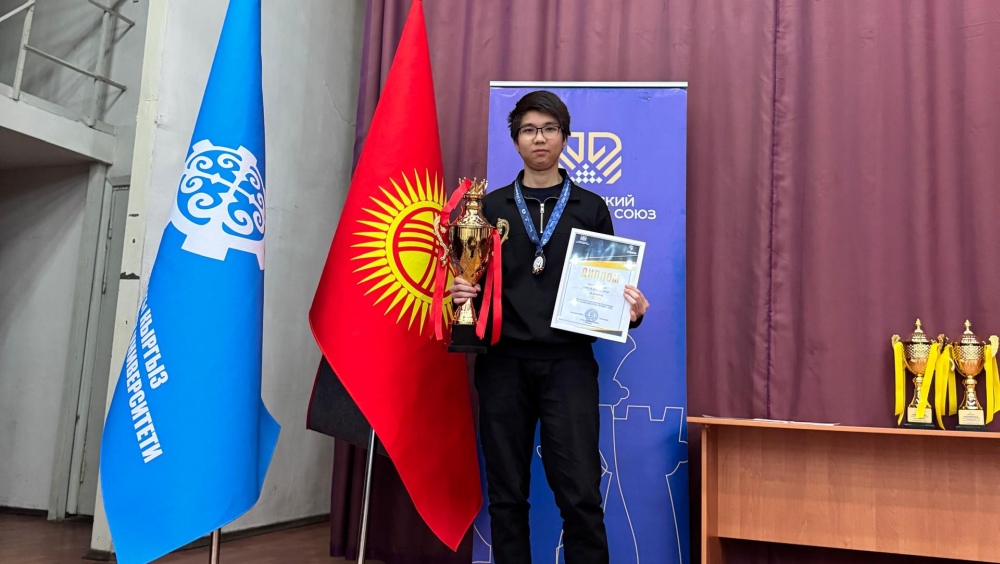
IM Eldiyar Orozbaev and WFM Begimai Zairbek Kyzy are the new chess champions of Kyrgyzstan. Organized by the Kyrgyz Chess Union in collaboration with the Directorate for Non-Olympic Sports of the Kyrgyz Republic, and supported by the general sponsor, financial company MBulak, the 2025 Kyrgyzstan Chess Championship took place from February 13 to 23 at Kyrgyz State Technical University, named after I. Razzakov. A total of 92 players participated in the championship, including 65 men and 27 women. Both the open and women’s events were Swiss tournaments (eleven and nine rounds, respectively) with classical time control. A panel of arbiters, led by IA Aziz Umarbekov, officiated the competitions. The open tournament was fiercely contested, culminating in a tiebreaker to determine the national champion. Remarkably, five of the top ten finishers, including the champion, are under twenty years of age. After IMs Eldiyar Orozbaev, Asylbek Abdyjapar, and Semetei Tologon Tegin tied for first place with 9/11, the top two players based on Buchholz tiebreak scores—Orozbaev and Abdyjapar—competed in a rapid tiebreak match. Top seed Orozbaev emerged victorious, winning both games to claim the title. Despite his excellent performance, Abdyjapar had to settle for second place, while Tologon secured bronze. Final Standings – Open 1 IM Orozbaev, Eldiyar U20 2403 9 2 IM Abdyzhapar, Asylbek 2353 9 3 IM Tologon Tegin, Semetei 2353 9 4 IM Khoroshev, Nikita 2359 8 5 CM Momunaliev, Ruslan U14 2032 7½ 6 Sulaimanov, Tilekmatali U18 1744 7½ 7 CM Sharshenbekov, Emir U16 2078 7 8 NM Takyrbashev, Bolot 2042 7 9 IM Markov, Mikhail 2255 7 10 IM Zhakshylykov, Erzhan U18 2310 7 In the women’s competition, which also featured a very young lineup, WFM Begimai Zairbek Kyzy (pictured below) claimed the national title with a strong score of 7.5 points out of 9. WFM Nuray Sovetbekova finished second, just half a point behind, while WCM Aizhan Sezdbekova completed the podium with 6.5 points. Final Standings – Women 1 WFM Zairbek Kyzy, Begimai 1848 7½ 2 WFM Sovetbekova, Nurai U20 1940 7 3 WCM Sezdbekova, Aizhan U16 1881 6½ 4 WCM Lesbekova, Assel 1952 6 5 WCM Zhanybekova, Begimay U18 1909 6 6 Tursunalieva, Nurelina U14 1697 6 7 Sagynbekova, Zhibek U12 1609 5½ 8 Poliak, Margarita U12 1762 5½ 9 Zhunusbekova, Aimonchok U16 1907 5 10 Sabyrbekova, Aizhan U14 1537 5 This event showcased the high level of competition in Kyrgyzstan, with the country’s best players battling for the titles. The Kyrgyz Chess Union expresses its gratitude to all participants, sponsors, and partners for their support in advancing chess in Kyrgyzstan. Congratulations to the winners! Photos: Kyrgyz Chess Union
Goryachkina and Tan strike back as Women’s Grand Prix heats up in Monaco
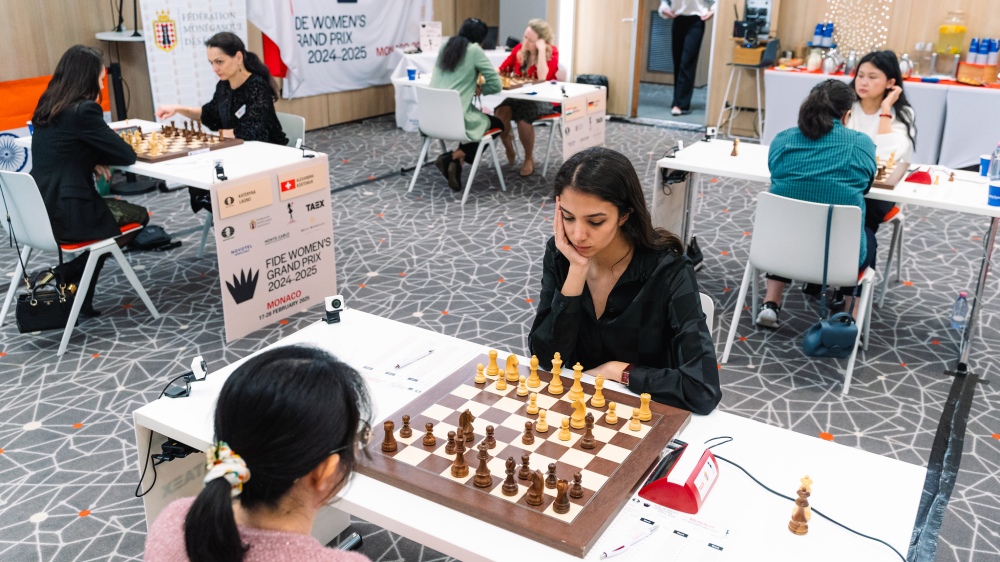
Round 6 of the FIDE Women’s Grand Prix in Monaco saw players return from their rest day with renewed energy as Tan Zhongyi and Aleksandra Goryachkina secured important victories whilst all other games were drawn. After a well-deserved rest day, the players were back for Round 6 of the FIDE Women’s Grand Prix in Monaco with a mix of refreshed determination and strategic focus. While some participants joined an organized excursion to explore Monaco, others opted for rest and quiet preparation. The impact of these choices varied, as some players returned reinvigorated, while others struggled to find their rhythm. The round delivered a mix of decisive results and hard-fought draws, with Aleksandra Goryachkina and Tan Zhongyi scoring crucial wins to keep their tournament alive. Meanwhile, Kateryna Lagno held her lead despite drawing her game, setting the stage for an intense second half of the tournament. Results Aleksandra Goryachkina 1-0 Humpy KoneruSarasadat Khademalsharieh 0-1 Zhongyi TanKateryna Lagno 1/2-1/2 Alexandra KosteniukBibisara Assaubayeva 1/2-1/2 Batkhuyag MunguntuulHarika Dronavalli 1/2-1/2 Elisabeth Paehtz Aleksandra Goryachkina – Humpy Koneru The Ruy Lopez is arguably one of, if not the top, most-played openings in the world which is why it is quite interesting that by move 10, Koneru took the game into a position not played before by introducing a novelty 10…Rd8. However, it was White who had an edge in subsequent play. Our commentators noted that Humpy played perfect chess, essentially completely equalizing. The opponents eventually reached a dry four-rook endgame that seemed to be heading to a draw (although it was always guaranteed to be a long grind – typical of both players) when Black, playing with only a minute, massively erred on move 39: Here, Humpy played 39…Ra8? instead of 39…Re8 (39…Ra4). White quickly capitalized on this mistake by doubling rooks on the h-file, which along with the threat of e6, spelled big danger for Black. After 40.Rh3 Ree8 41.Reh1 Kf8 42.e6 Ra4? 43.exf7 White eventually got to f7-pawn, created two advanced passers to score a full point. With this victory, Goryachkina has clawed her way back into the race, sitting just half a point behind leader Kateryna Lagno. Sarasadat Khademalsharieh – Tan Zhongyi Tan Zhongyi, the Women’s World Championship Challenger, had struggled in Monaco before the rest day, with four draws and a loss in her first five games. However, as is often the case at the elite level, a break proved invaluable—Tan came back rejuvenated and delivered a strong performance. Playing with Black in Queen’s Gambit Declined, Tan quickly gained a superior position, but White still have defensive resources. In the critical phase around move 40, both players entered time trouble, leading to mutual inaccuracies. The engine evaluated this as -0.4, indicating a slight edge for Black. However, Tan’s position was much easier to play in a real game, with an active queen and bishop, as well as White’s exposed king. Khadem soon bulked under pressure, attempting to trade queens when she desperately needed to find a defensive move with her knight. Instead of 42.Nd2! with a holdable position, Sara played 42.Qb2? but after 42… Qe4+ 43. Kd2 Qg2+ 44. Kc3 Qf3+ 45. Kd2 Be4! it was all over for White. Tan systematically picked up White’s weak pawns, eventually forcing resignation by move 60. This victory is a much-needed boost for Tan as she seeks to build momentum in the tournament’s second half. Kateryna Lagno – Alexandra Kosteniuk At 99% accuracy for both players, this was an exceptionally precise game. A well-known line of the Four Knights Scotch, lead to a fascinating sequence of desperado trades. The resulting endgame left both players with a rook, bishop, and a few pawns, with Lagno holding an extra pawn. However, opposite-colored bishops ensured complete equality, making a draw the logical conclusion. A threefold repetition sealed the result. Lagno remains the sole tournament leader, albeit with a shrinking margin. Bibisara Assaubayeva – Batkhuyag Munguntuul A Sicilian Taimanov quickly became an exciting affair, with Black pushing on the queenside, and White pressuring in the center and kingside. Then, at move 13, Black – already down in time by 30 minutes – made a serious mistake by castling Kingside onto a semi-open g-file. After castling, Black’s king fell out of the frying pan into from the fire. White had a golden opportunity to lauch a dangerous kingside attack with 14.Qh5 f5 15.Rg1 (followed by pushing g4). Given Assaubayeva’s aggressive style, this move was right up her alley—yet she hesitated, spending 13 minutes before choosing 14.h4 instead. Munguntuul defended resourcefully, gradually reaching a balanced position hold a draw. After the game, Assaubayeva admitted that she missed the key attacking idea of Rg1 followed by g2-g4. She also revealed that she has been struggling with health issues, affecting her form. Despite this, she remains determined to finish strong and is aiming for at least one victory before the tournament ends. Harika Dronavalli – Elisabeth Paehtz The game began with 1.c4, transposing into a Sicilian Accelerated Dragon with a Maroczy Bind. Paehtz demonstrated good preparation, employing the thematic idea of advancing her a-pawn, quickly gaining a time advantage on the clock. Both players invested a significant amount of time in subsequent maneuvering and by move 27 Harika was down to less than 5 minutes. However, in a wise practical decision, she opted to simplify the position, trading into an opposite-colored bishop endgame, which offered complete equality. A draw was agreed soon after. With just three rounds remaining, the battle for first place is heating up. Kateryna Lagno continues to lead, but Goryachkina’s win has put her within striking distance, joined by tournament underdog Batkhuyag Munguntuul. Standings after Round 6: 1 GM Kateryna Lagno 2515 4 2 IM Batkhuyag Munguntuul 2331 3½ 3 GM Aleksandra Goryachkina 2546 3½ 4 GM Alexandra Kosteniuk 2484 3 5 GM Zhongyi Tan 2561 3 6 GM Humpy Koneru 2523 3 7 IM Sarasadat Khademalsharieh 2458 3 8 GM Elisabeth Paehtz 2427 2½ 9 IM Bibisara Assaubayeva 2492 2½ 10 GM Harika Dronavalli 2489 2 Round seven
First Continental Online Chess Championships for Prisoners announced

The first-ever Continental Online Chess Championships for Prisoners will take place in May 2025, marking a significant milestone in the effort to bring chess into correctional institutions worldwide. As part of the Chess for Freedom initiative, this expansion provides incarcerated individuals with new opportunities for intellectual engagement, rehabilitation, and reintegration into society. The event will feature separate championships for four continents: Africa – May 13, 2025Americas – May 16, 2025Europe – May 20, 2025Asia – May 23, 2025 Tournament Format & Eligibility Each championship is a team event, open to correctional institutions within their respective continents. Each country may register up to three teams: One team from a male correctional facility One team from a female correctional facility One team from a juvenile correctional facility (under 20 years old) Additional teams may be invited from countries that organize national championships among prisoners. Each team will consist of four players, with an unlimited number of substitutes. All participants must be incarcerated individuals, and anonymity will be maintained in accordance with legal regulations. The tournaments will be played on Chess.com, using a 10-minute + 5-second increment time control. The format – Round Robin or Swiss System – will depend on the number of participating teams. The top two teams in each continental event will advance to the Championship Match (which will be held on the second day) to determine the continental winner. Registration & Key Dates Registration Deadline: May 1, 2025 Registration Link: Click HERE to register Technical Meeting: Week of May 5, 2025 (via Zoom) Correctional institutions must complete the online registration form and confirm their team’s participation via email to Mikhail Korenman (mikhail.korenman@ccsheriff.org). Since its launch in 2021, the Chess for Freedom initiative has introduced chess to correctional institutions around the world, demonstrating its value as a tool for education, personal development, and social reintegration. The introduction of continental-level championships represents a step forward in expanding access to the game, allowing teams from different regions to compete on a larger stage. For full tournament details, please refer to the official event guidelines. Regulations for Continental Online Championships for Prisoners (PDF)
World Senior Championships 2025: Four-way tie in 50+; England leads 65+
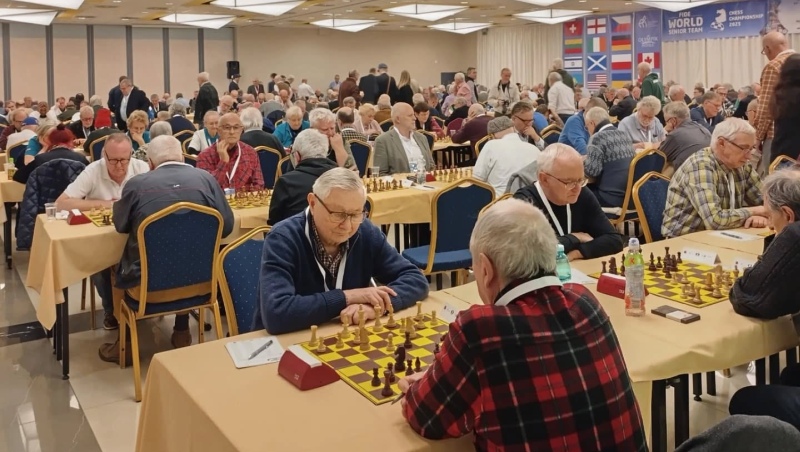
The 2025 World Seniors Team Chess Championship in Prague is entering its final stages. With just three rounds to go, both the 50+ and 65+ competitions remain wide open, setting the stage for an exciting finish. After six rounds in the 50+ section four teams–England 1, USA, Slovakia and Italy– share the lead on 10/12 points with England 1 holding the top spot due to a greater number of points. Round 7 will feature key matchups between the leaders, as USA faces Italy while Slovakia takes on England 1. In the women’s standings, China leads with 8/12 points, closely followed by Czech Women and the USA. 50+ standings after Round 6 In the 65+ category, England 1 leads with 11/12 points, having won five matches and drawn just one against Lasker Schachstiftung GK, which trails by a single point on 10/12. Five teams—France, England 2, Israel, Hungary, and Norge – OSS—are tied for third place. Round 7 will see England 1 tested by France, while Lasker Schachstiftung GK faces Norge – OSS, and England 2 plays Israel. 65+ standings after Round 6 The tournament has already produced many remarkable encounters, with the best game of each round being awarded a special prize. GM Lexy Ortega from Italy won the first-round award (a small chess horse), followed by English GM Michael Adams, Swedish IM Nils-Gustaf Renman, Dutch FM Prakken Gerrit and Moshe Gal of Israel (pictured below). On the rest day, February 22, participants had the opportunity to take a guided tour of Prague, the stunning capital of the Czech Republic. Additionally, a blitz tournament was held, with Jaan Ehlvest emerging as the winner. Photos: Ave Chess
Midway through FIDE WGP Monaco: All draws in Round 5
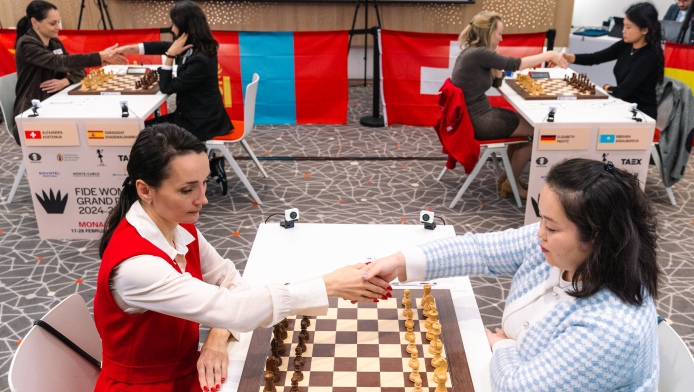
As the third leg of the 2024/25 FIDE Women’s Grand Prix series reaches its halfway mark, Round 5 saw all five games end in draws—yet the results hardly tell the full story. Despite the peaceful outcomes, the battles were anything but uneventful, with players pushing hard, missing key opportunities, and ultimately splitting the points in tense encounters. With the only rest day ahead, the tournament remains wide open, and the second half promises even more excitement. Round 5 results: Harika Dronavalli 1/2-1/2 Aleksandra GoryachkinaElisabeth Paehtz 1/2-1/2 Bibisara AssaubayevaBatkhuyag Munguntuul 1/2-1/2 Kateryna LagnoAlexandra Kosteniuk 1/2-1/2 Sarasadat KhademalshariehZhongyi Tan 1/2-1/2 Humpy Koneru Harika Dronavalli – Aleksandra Goryachkina Starting off with a Ruy Lopez Berlin, one of the most solid systems in chess, a draw was not a surprising result, although the game did offer excitement regardless of the opening’s reputation. A slow game unfolded, with multiple trades in the middlegame, leading to a roughly equal position. After inaccurate play by White, Black obtained an advantage, with the chance to press for a win. At this point, Black had an opportunity to exert real pressure with 26…Na6 with the idea of 27…Nc5, which is the best square knight in this structure (26… Rd6 was also a very strong option). However, Goryachkina should have weighted the consequences of the line 27. Qb7 Nc5 28.Qxc7, in which Black sacrifices a pawn for positional compensation. Aleksandra opted for 26…Qd6 and after 27.h5 Qf6, White gave Black another chance to grab initiative with 28.Re1? by simply capturing on h5, as Qh4 was no longer a threat. Instead, 28…Qg5 balanced the game again. After further exchanges, a draw was agreed. Goryachkina missed a few chances, but given the grueling pace of the tournament, fatigue is a factor. With the rest day ahead, both Harika and Aleksandra will look to recharge before the crucial second half. Elisabeth Paehtz – Bibisara Assaubayeva After suffering a dramatic loss in the previous round, Paehtz chose not to retreat into a cautious approach, but instead opted for an aggressive response to Assaubayeva’s Najdorf. White emerged from the opening with a dominant position: Here, Paehtz played 17.Ba4?, allowing Black to escape via queenside castling. A stronger alternative would have been a queen move, followed by placing the bishop on e6, where it would dominate the board. After 17…0-0-0 18.0-0-0 Qc7 19.Bb3? Na5, White’s advantage evaporated. Our commentators analyzed the fascinating move 19.Rd5!, a practical shot that could have led to an imbalanced fight. After 19…Ne7 20.Qb3, White would allow Black to capture the rook, gaining a dangerous initiative in return. Instead, the game equalized and ended in a threefold repetition. Despite the missed opportunity, Paehtz’s combative approach is a promising sign for the second half. Meanwhile, Assaubayeva, who stabilized after her third-round loss to Goryachkina, will look to regain momentum. Batkhuyag Munguntuul – Kateryna Lagno Munguntuul has been one of the tournament’s surprises, delivering a strong performance with an undefeated streak so far. She tested the Caro-Kann Defense, which is part of her regular repertoire, in her game against Lagno. Black managed to win a pawn, but at the cost of compromising her pawn structure. This positional imbalance allowed White to generate sufficient counterplay, ultimately leading to a draw. For Munguntuul, this is an impressive result. She was not only the rating underdog by 184 points, but she also endured a tough previous Grand Prix leg, losing all her games with White. Now, she stands within reach of a potential GM norm, should she continue this solid run. Meanwhile, Lagno retains her tournament lead, thanks to an all-draw round. Alexandra Kosteniuk – Sarasadat Khademalsharieh The first game of the day to finish was the encounter between Kosteniuk and Khadem that ended in a draw. What started as an interesting line in the Queen’s Gambit Declined Exchange Variation reached this fresh position after Black’s 11…Bb4: Commentators noted that 12.Kd2 was a slightly more accurate, whereas 12.Bd3 played by Alexandra allowed Black to get counterplay after exchanging on c3 and eventually bringing the knight to the c4 outpost. Despite the seemingly vulnerable kingside pawn structure, Black’s position remained stable, supported by the king and the open g-file. After multiple trades, the game ended in a threefold repetition. Zhongyi Tan – Humpy Koneru Tan, one of the pre-tournament favorites, has faced unexpected difficulties in Monaco. She entered today’s game with solid preparation in the Neo-Catalan Defense Declined, often employed by her compatriot Ding Liren. Initially, White achieved a comfortable position, but mishandled it shifting focus between the queenside and kingside, giving Koneru to arrange her pieces on optimal squares and reach a winning position. White had already gone with the incorrect plan of pushing her kingside pawns, but here the 27.f6 does not amount to any attack as the natural 27…g6 stops everything and suddenly the white king is exposed and in danger. However, Humpy incorrectly played 27…Ng4? picking the f6-pawn but letting White off the hook. Instead, maintaining control and launching an attack on the white king was much more dangerous for White. In a post-game interview, Humpy noted that she thought she must have been better and did in fact calculate the 27…g6 variation, but was not sure about it. The game instead continued with multiple trades where Black managed to hold onto the extra pawn, resulting in a drawn knight endgame where both sides had passed pawns that did not offer any real danger. The final handshake came after 4.5 hours of play, bringing an intense game to a peaceful conclusion. With the first half of the event behind us, the tournament heads into its only rest day, when players will enjoy an excursion in Monaco. This break comes at an ideal moment, offering a mental reset before the decisive second half of the competition. Standings after Round 5: 1 GM Kateryna Lagno 2515 3½ 2 GM Humpy Koneru 2523 3 3 IM Sarasadat Khademalsharieh 2458 3 4 IM Batkhuyag Munguntuul 2331 3 5 GM Alexandra Kosteniuk 2484 2½ 6 GM Aleksandra Goryachkina 2546
FIDE WGP Monaco Round 4: Kateryna Lagno takes the lead with a spectacular victory

Round 4 of the FIDE Women’s Grand Prix in Monaco delivered high-level chess, with four games ending in draws and one spectacular victory. Kateryna Lagno, playing a breathtaking attacking game, defeated Elisabeth Paehtz to seize the sole lead in the tournament. The day began on a lighthearted note as Michael Stoettinger, President of the Austrian Chess Federation and host of the final WGP leg, made the ceremonial first move for Lagno—perhaps bringing her a touch of good fortune. Meanwhile, tournament director Jean-Michel Rapaire outlined plans for the upcoming rest day on February 23, which will feature an exciting excursion. Stoettinger added a humorous remark about the Austrian rest day including schnitzel and Vishy Anand, drawing smiles from the players. As for the games – despite the draws on most boards, the games were far from dull. Sara Khadem misplayed a significant advantage, while Humpy Koneru and Aleksandra Goryachkina also had opportunities to press for more. Round 4 results: Aleksandra Goryachkina ½-½ Zhongyi TanHumpy Koneru ½-½ Alexandra KosteniukSarasadat Khademalsharieh ½-½ Batkhuyag MunguntuulKateryna Lagno 1-0 Elisabeth PaehtzBibisara Assaubayeva ½-½ Harika Dronavalli Kateryna Lagno – Elisabeth Paehtz The sole victory of the round was a dazzling display of creativity and fighting spirit, making it an early frontrunner for the tournament’s brilliancy prize. The game began at an unusually slow pace, with only eight moves played in the first hour and a half. By move six, the players had entered an unexplored variation of the Queen’s Gambit Declined. Lagno, with the white pieces, gained an edge out of the opening and soon shook things up with a pawn sacrifice: In the post-game interview, Lagno explained her reasoning behind the sacrifice, aiming to delay Black’s ideas of 12…Nc5 and 12…Bf5. Paehtz responded with 12…Nc5 instead of the stronger 12…Bxe6, allowing the game to spiral into chaos, ultimately favoring White. I implore you to really assess the intricacies of this position – there is so much going on from both sides. White’s last move, 16.g4! (the best in the position), gives up a pawn to distract what Lagno considered to be Black’s strongest piece – the light-squared bishop. However, after 16…Bxg4 White erred with 17.Ne5? Allowing Black to come back into the game with 17…Bxd1 although practically, and in the spirit of the game, White’s decision made sense to target the g6-pawn. A key moment came after move 19, where Paehtz missed a crucial defensive resource: Here 19…Bg5 (or the fancier 19…Qxd2 achieving the same) was the only way for Black to continue. This would force a series of trades where White would end up with only a slightly better position – which Lagno noted she had calculated and was happy with. Nevertheless, Paehtz opted for 19…e3 which closed the important diagonal and did not achieve much. 20.fxe3 Kxg6 21.Rg1 Bg5 22.h4! The exposed black king was in trouble, and after picking off the bishop, White brought her pieces to the party. Playing under time pressure, both sides exchanged inaccuracies where Black had one last opportunity to prolong her resistance after 27.e4: Here 27.Rd1 instead was important to insert before e4, setting up a discovery on the black queen where e4 becomes even stronger with the threat of Bxg5 (in all fairness, Black’s position was already beyond repair). 27…Qd4 was played in the game, to which White responded with 28.Rf1 and now 28…Ncd7?? was Black’s final major blunder as she incorrectly defended her f6-knight. There is a lot of tricky analysis here to look into, but instead I will leave you with the remainder of the beautiful game: 29.Bxg5 Rhf8 30.Be6 Rad8 31.Bxd7 Rxd7 32.e5 Kd8 33.Bxf6 Kc7 34.e6 Qd2 35.Kb1 Rd6 36.e7 Re8 37.Be5 Rxe7 38.Rd1 and Black resigned. With this victory, Lagno emerged as the tournament leader. As she left the hall, she remarked with a smile that this was the best game she had played in a long time. Aleksandra Goryachkina – Tan Zhongyi For the second consecutive day, Goryachkina was the last player to leave the board, battling for nearly five hours. Both players blitzed through the opening in Petroff Defence and entered a slow, positional struggle. Much like her previous game against Assaubayeva, Goryachkina attempted to squeeze out a win from a seemingly equal position. Several moments arose where a threefold repetition seemed imminent, but each time, one player deviated to continue the fight. Tan, however, handled the clock better, maintaining a significant time edge—42 minutes against Goryachkina’s mere 3 minutes. Time trouble has led to several blunders in this event, but today, both players held firm, agreeing to a draw after 93 moves. Humpy Koneru – Alexandra Kosteniuk A Semi-Slav set the tone for a long positional game, and this is what occurred in the game between Koneru and Kosteniuk, with the opponents performing at 98% accuracy. This stat makes a draw between two chess titans the logical outcome. White obtained a more comfortable position out of the opening and had a 20-minute time advantage by the ninth move. However, this was soon balanced, as became the position. Play unfolded on the queenside, where both sides made the best moves, leading the game to a natural draw – even though Humpy had chances to push for more. Although we did not see fireworks in this game, it was a display of the high-quality chess that we are witnessing in this event. Sarasadat Khademalsharieh – Batkhuyag Munguntuul Another incredibly instructive game was played in which White got a desirable position out of the opening but could not convert it, leading to a draw. Black did not make any obvious error in an Exchange Slav but allowed White to dominate the queenside by controlling the backward c6-pawn without any counterplay. White solidified her strong position with a3 and b4, eventually activating her queen and taking advantage of Black’s passivity, picking up a pawn: The h5-pawn is under attack, while White threatens Rxd5 as the c7-rook is hanging. Despite this material and positional advantage, it was still not that easy to breakthrough – something Khadem
FIDE WGP in Monaco: Four in the lead after Round 3
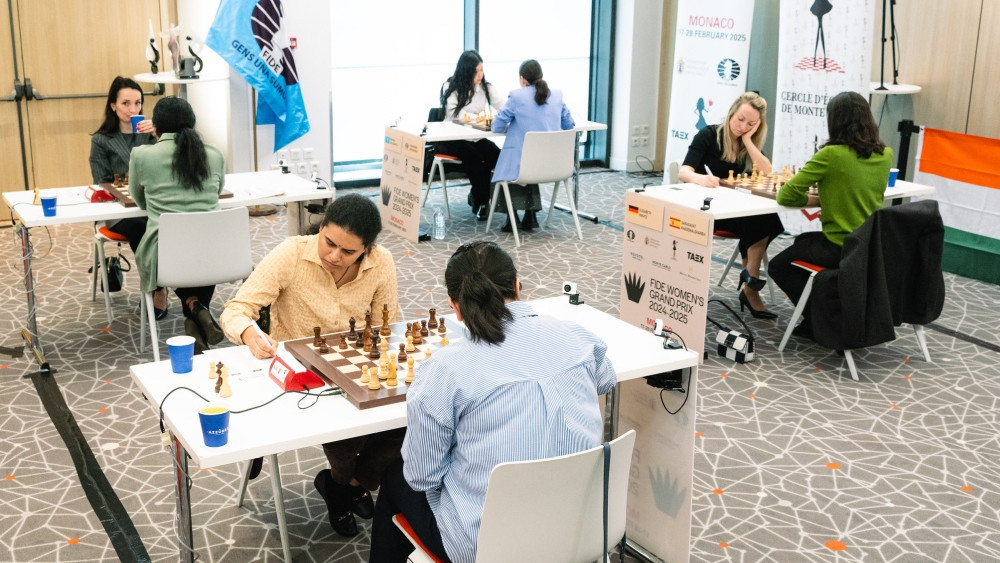
The third round of the FIDE Women’s Grand Prix 2024-25 in Monaco saw intense battles on the boards, with three draws and two decisive outcomes. Alexandra Kosteniuk secured a crucial victory against Tan Zhongyi in a clash of former World Champions, while Aleksandra Goryachkina outlasted Bibisara Assaubayeva in a tough five-and-a-half-hour struggle. The round began with a special guest making the ceremonial first move—Monaco basketball star Donatas Motiejūnas and his son played 1.a3 on the board of Alexandra Kosteniuk vs. Tan Zhongyi, a move that sparked smiles and set a lighthearted tone before the intense battles unfolded. Round 3 results: Bibisara Assaubayeva 0-1 Aleksandra GoryachkinaHarika Dronavalli 1/2-1/2 Kateryna LagnoElisabeth Paehtz 1/2-1/2 Sarasadat KhademalshariehBatkhuyag Munguntuul 1/2-1/2 Humpy KoneruAlexandra Kosteniuk 1-0 Zhongyi Tan Alexandra Kosteniuk – Zhongyi Tan A clash of two former Women’s World Champions saw an exciting battle! Kosteniuk had a rough start to the event, facing critical time trouble in the first game, and not feeling too happy with her decisions in the second. However, she achieved a good position out of the opening. The middlegame became quite complex, with Black playing all the best moves up until a critical point. 19…Rf5? This seemingly active move turned out to be a serious inaccuracy, that handed White considerable advantage. After reserved 19…a6 or 19…Rc6 Black would have kept the position in balance. Kosteniuk remarked after the game that she was confused by her opponent’s decisions. More errors by Black led to a position where White was suddenly much better. Even though Tan made multiple attempts to complicate things and make them as difficult as possible for her opponent, particularly in mutual time trouble, Kosteniuk responded accurately to every threat, transitioning into a position with a queen and two extra pawns, against Black’s knight and rook. In an endgame that ensued, Kosteniuk showcased her great technique, crashing all Black’s hopes to build a fortress. In an interview yesterday, Kosteniuk noted that she plays tournaments to enjoy chess and play her best, as she already has so many titles under her belt. This healthy mindset coupled with her vast experience always makes her an interesting player to watch, particularly in this event, as she has picked herself up to score an important victory. Bibisara Assaubayeva – Aleksandra Goryachkina The highly anticipated clash between Grand Prix leader Assaubayeva and Leg 2 winner Goryachkina delivered an intense, strategic battle. The game followef an English Opening, with both players navigating unfamiliar territory. White advanced on the kingside while Black countered on the queenside. Despite Assaubayeva securing a protected passed pawn in the middlegame, the position remained closed and difficult to break through. Assaubayeva missed the strong 21.Ba3, which would have significantly improved her worst-placed piece by activating the bishop and exerting pressure on Black’s position. Instead, 21.Bd2 was played, resulting in a prolonged maneuvering battle where neither side could make immediate progress. As the game evolved and the queenside began to open up, Goryachkina gradually took control. Even though the engine assesses this as -3, it is still not easy, a fact that is compounded when you take into consideration that both sides were playing with under two minutes left on their clock. For this reason, both sides exchanged inaccuracies as tension was extremely high. Goryachkina, with experience on her side, remained calm and composed, picking up important pawns to execute a victory. After her first-round loss to Kateryna Lagno, this win puts her back in the running to have a successful tournament. I want to note that this game was played over five and a half hours! Harika Dronavalli – Kateryna Lagno A solid line of the King’s Indian Defense led to a comfortable position for White. While Dronavalli had a chance to press for an edge, she missed a good opportunity to build up pressure on move 20 and opted for a seemingly active but wrong continuation, which lead to multiple trades and an equal position. A threefold repetition sealed the draw. This result was significant for Dronavalli, as it ended her two-game losing streak. After yesterday’s tough loss, stabilizing against one of the tournament leaders was a confidence-boosting result. For Lagno, a draw with Black is a solid outcome, allowing her to conserve energy for upcoming rounds. Elisabeth Paehtz – Sarasadat Khademalsharieh The opponents tested the Exchange Variation of Ruy Lopez that quickly led to a queenless game in which neither side pushed hard. Black had an opportunity to gain a slight advantage, but it was hardly enough to make further progress. The only winner in Round 2, Sara has performed much better than her first Grand Prix leg in Tbilisi, whilst Elisabeth is also in better form compared to her Shymkent showing. Batkhuyag Munguntuul – Humpy Koneru While this game ended in a draw, it was full of exciting tactical opportunities. The key moment came in the early middlegame: In this position, after thinking for 16 minutes, Munguntuul played a timid 14.Be2? instead of launching a dangerous kingside attack with 14.Ng5! In the line 14…g6 15.Qf4 White has a great attacking opportunities, whereas 14…h6 15.Nh7 Re8 16.Qf4 is equally unpleasant for Black. White has ideas of bringing the rook to the chaos with Rae1-e3 and Nf6+! ripping black kingside open. In a post-game interview, Munguntuul admitted she had considered Ng5 but decided against it, fearing excessive risk. Choosing the safer Be2, she steered the game toward a balanced endgame, and a draw was eventually agreed upon. Standings after Round 3 1 GM Humpy Koneru IND 2523 2 2 IM Sarasadat Khademalsharieh ESP 2458 2 3 IM Batkhuyag Munguntuul MGL 2331 2 4 GM Kateryna Lagno FID 2515 2 5 GM Alexandra Kosteniuk SUI 2484 1½ GM Aleksandra Goryachkina FID 2546 1½ 7 GM Elisabeth Paehtz GER 2427 1½ 8 GM Zhongyi Tan CHN 2561 1 9 IM Bibisara Assaubayeva KAZ 2492 1 10 GM Harika Dronavalli IND 2489 ½ Round 4 pairings and dates The fourth round of the third leg in the 2024/25 Women’s Grand Prix series starts on Friday, February 21st
Join Global Celebration of Women and Girls in Chess!
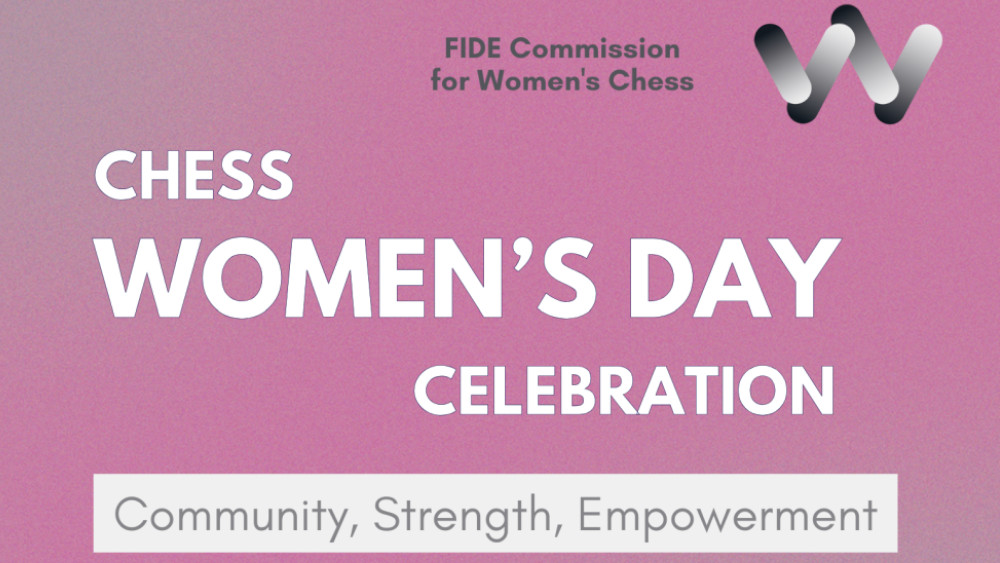
March is a time to celebrate women, and what better way to do so than through chess? The FIDE Commission for Women’s Chess invites federations, clubs, and organizers worldwide to be part of the Chess Women’s Day Celebration: Community, Strength, Empowerment – our initiative to connect chess community on this special occasion for women and show how many incredible projects happen worldwide. Are you planning a chess event in March to honor and inspire women and girls in the game? Whether it’s a tournament, a simultaneous exhibition, a workshop, or a special gathering, we want to hear about it! By joining this global initiative, your event will be part of a worldwide network of activities that showcase how community empowers us as individuals, and how each of us contributes to uplifting the community. Each of your events will empower this global celebration! Together we will create a movement that highlights the role of women, chess and communities in creating a better space for us all, inspiring even more to join through the power of shared experiences and celebrations. How to Get Involved: Plan a chess event dedicated to celebrating women and girls. Let us know about it by reaching out to us! Join a global movement to promote and empower women in chess. Contact us to be part of this special celebration! Together, we can create a powerful impact and inspire the next generation of women and girls in chess. For more details and to share your event with us, contact us here: anna.kantane@gmail.com
FIDE School Award winners celebrated at 2nd cycle webinar

The FIDE Chess in Education Committee recently hosted an online seminar to honor the recipients of the second cycle of the FIDE School Awards. This award recognizes excellence in school chess programs that have a dedicated focus on chess as an educational tool, have a demonstrable impact on their local communities, and maintain a sustainable model for engaging community and promote the educational and social/emotional benefits of chess. The awards are presented in gold, silver, and bronze categories based on a dozen assessment components. The evaluation focuses on three key aspects: chess an educational tool, the school’s impact on community and culture, and innovation. There are several ways chess programs can make a difference, but the ultimate goal remains the same: to raise awareness about the power of educational chess in schools to transform lives. One of the highlights of the webinar was the presentation of school programs, offering participants a glimpse into the diverse ways different schools go about integrating chess into education. These presentations also showcased the variety of methods different cultures approach the idea of chess as a means of enhancing education in many other subjects. Here is a quick overview of two of the award-winning schools that presented during the seminar: Overseas Family School (Singapore) The chess program at Overseas Family School (OFS) was a recipient of the FIDE Gold School award. Their program features a robust teaching component that has chess as a mandatory subject for grades K-5. They support kids learning at their own pace and developing a love for the game and incorporate innovative learning tools to assist children in learning, including chess yoga and songs. The school also engages the local and international chess community by organizing events that raise social awareness, such as their Checkmate to Racism initiative. Click HERE to learn more. Colegio Kender (Durango, Mexico) A recipient of the FIDE Gold School Award, Colegio Kender integrates both over-the-board and digital learning tools in a dedicated chess space on campus, to tell children about the transformative lessons chess can offer. The school organizes competitive tournaments and fun in-school events, such as Halloween Chess Night. Colegio Kender also promotes chess beyond the classroom by hosting public chess activities in community spaces. Chess is deeply embedded in the school’s culture, with students actively participating from early education through high school. Click HERE to learn more. Benefits of the award Beyond the prestige of recognition by FIDE, award-winning schools receive tangible benefits to further enhance their chess programs and introduce new tools including: ChessKid memberships – up to 500 Gold memberships (for 4 months) for their school. One-year Premium membership for your school on LearningChess.net One-year Premium LogiqBoard license for up to five teachers. Six months’ free Notationary.app membership for teachers. Discount for teachers of your school to attend an online Preparation of Teachers (PoT) Course. 20% for Bronze, 30% for Silver and 50% for Gold Award-winning schools. Collaboration and communication is key Of fundamental importance in keeping the momentum of the movement of educational chess is spreading the message through the collaboration of programs. FSA award winners were encouraged to connect with each other and find ways to create international partnerships and cultural exchanges to share ideas and open opportunities for kids to engage with each other. These collaborations do not have to be purely competitive, though a combination of friendly competition with cultural exchanges can be very fruitful. For example, two schools from the first cycle of awards, Hamilton K-8 School from the USA and G C School of Careers from Cyprus, played an online friendly match with. The kids from both sides had a great deal of fun and the event was celebrated in their communities. Promoting such international collaborations helps reinforce chess’s educational, social, and cultural benefits, extending beyond critical thinking into the social and cultural realms. Applications are open for the 3rd Cycle! Applications for the third cycle of the FIDE School Awards are now open and will close on April 30, 2025. We encourage schools committed to use chess as a tool for uplifting and enhancing the educational journey of a child to apply. There is no single approach to intergrading chess into education-different schools and communities do it in unique ways. Competitive chess is not a requirement for eligibility, what matters is demonstrating meaningful impact through chess. FIDE EDU invites you to share your stories with us so that we can all learn and help educate our communities about the transformative power of chess. Congratulations to the winners of the second cycle! Clink HERE for more information about the application. Written by Abel Talamantez
Social Chess Research Conference announced
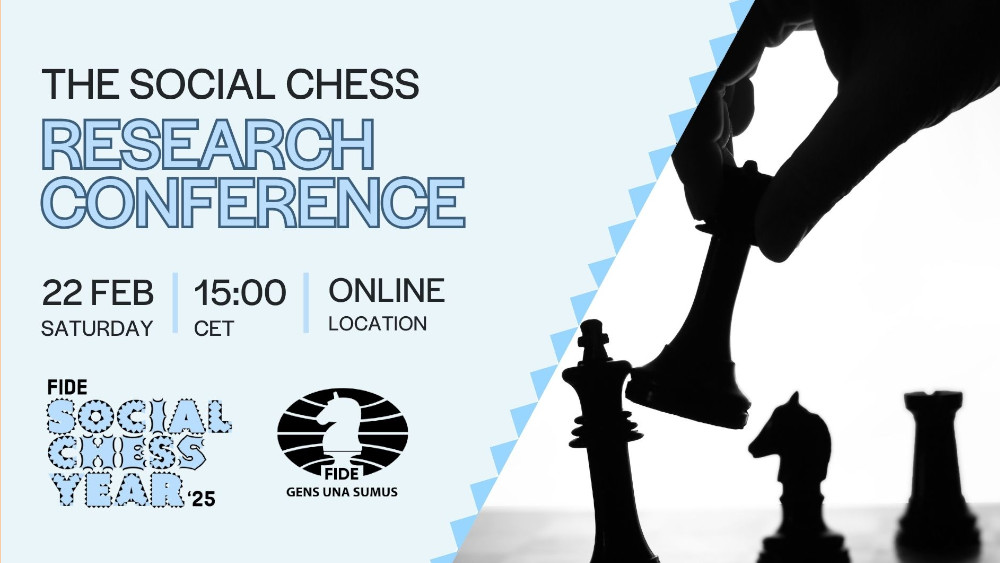
FIDE is thrilled to invite you to the Social Chess Research Conference, an online event bringing together researchers, educators, practitioners, and chess enthusiasts to explore how chess contributes to improving quality of life, fostering social development, inclusion, empowerment, and rehabilitation. Date: Saturday, February 22, 2025Time: 15:00-19:30 CETLocation: Online (Zoom) This unique conference serves as a platform to highlight innovative applications of chess, from research breakthroughs to real-world stories of empowerment and hope. Program Structure 15:00–15:15 | Welcome Address by Dana Reizniece, Deputy Chair of the FIDE Management Board and Andre Vögtlin, FIDE Social Commission Chair 15:15–15:20 | FIDE Social Chess Videos 15:30–17:45 | Chess Research Presentations Prof. Filip Kobiela, “Chess as a challenge for the traditional definition of sport” (20 min) Dr. Giovanni Sala, “Chess and Mathematics in Primary School” (20 min) Juan Antonio Montero Aleu, “Cognitive Training of the Mind Through Chess: ECAM and Gymchess” (20 min) Prof. Dr. Sabine Vollstaedt-Klein, “Why chess is good for the brain and can be helpful against addiction” + “Introducing the International Society for Applied Chess (ISAC)” (45 min) Prof. Dr. Peter Hersics, “Learnings from EEG Neurofeedback System” (20 min) 17:45–18:00 | Chess Research Project Pitches Rodrigo Barbeito, “Social and Therapeutic Chess: A New Look from the Social Sciences” Dr. Uvencio Blanco Hernández, “Green Boards for Peace: bridges between chess and education to raise awareness about biodiversity and environmental sustainability” 18:00–18:20 | Breakout Sessions – Participants can join breakout rooms, each representing one of our social chess projects: Chess for Freedom Chess for Protection Infinite Chess – Autism Chess4Longevity – Elderly Chess4Hope – Underserved communities Chess4Recovery – Addiction/Cancer In these breakout sessions, scientific and operative questions can be raised and discussed among participants. Moderators will document the discussions and present a summary in the main session once the rooms close. 18:20–19:00 | Reporting from the Breakout Sessions 19:00–19:30 | Closing Remarks & Future Collaboration Opportunities Why Attend? This conference offers an inspiring blend of keynote presentations, interactive discussions, and thought-provoking panels, connecting a diverse community of individuals dedicated to leveraging chess as a tool for social transformation. Registration Register here: https://forms.gle/6quumvjkrAxadBWG8 Zoom link will only be sent to registered participants.

